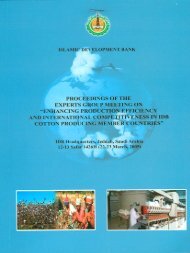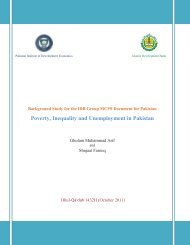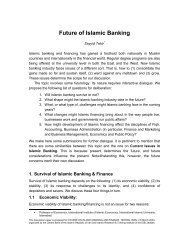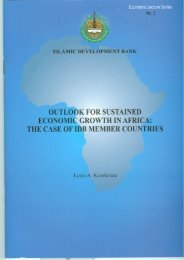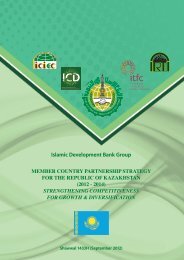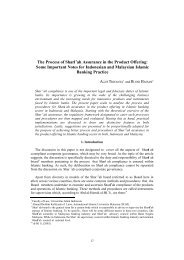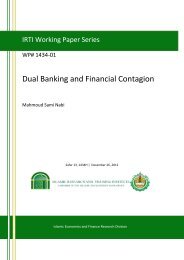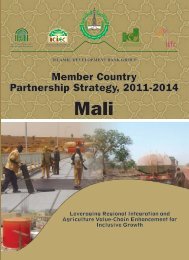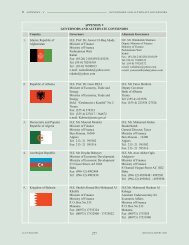Country Economic Work for Malaysia - Islamic Development Bank
Country Economic Work for Malaysia - Islamic Development Bank
Country Economic Work for Malaysia - Islamic Development Bank
Create successful ePaper yourself
Turn your PDF publications into a flip-book with our unique Google optimized e-Paper software.
I. DIAGNOSING THE MALAYSIAN ECONOMY:<br />
SOCIO-ECONOMIC DEVELOPMENT<br />
1. As part of its Vision 1440H (2020), the IDB Group embarks on Member <strong>Country</strong><br />
Partnership Strategy (MCPS) <strong>for</strong> its member countries, aimed at improving the efficiency and<br />
effectiveness of Group operations through close consultation with the key stakeholders. Be<strong>for</strong>e<br />
preparing any MCPS, it is extremely important to undertake a proper diagnostic of the country in<br />
order to understand key socio-economic challenges facing the country, particularly, identifying<br />
the binding constraints to achieving sustainable economic growth. Adopting this process, the IDB<br />
Group can assist the country in more effective way through the MCPS exercise.<br />
2. Be<strong>for</strong>e undertaking the MCPS <strong>for</strong> <strong>Malaysia</strong>, the IDB Group MCPS Team initiated the<br />
<strong>Country</strong> <strong>Economic</strong> <strong>Work</strong> (CEW) aimed at providing analytical analysis of recent socio-economic<br />
development and major challenges facing the country. In particular, the CEW focuses on<br />
identifying binding constraints to achieving sustainable economic growth in <strong>Malaysia</strong>. Further,<br />
through extensive consultation with key stakeholders (public sector, private sector, business<br />
community, academia, civil society etc.), two main pillars namely (i) Private Sector<br />
<strong>Development</strong>; and (ii) Reverse Linkages have been identified <strong>for</strong> the IDB Group support over the<br />
next 4 to 5 years. There<strong>for</strong>e, in-depth diagnostics have been undertaken <strong>for</strong> these two sectors in<br />
order to find out niche areas <strong>for</strong> IDB Group interventions. This <strong>Country</strong> <strong>Economic</strong> <strong>Work</strong> uses the<br />
latest available in<strong>for</strong>mation and data from reliable national and international sources.<br />
3. The CEW document is structured as follows. Recent socio-economic developments of<br />
<strong>Malaysia</strong> are analysed in Section II. Major issues and challenges facing the country are<br />
highlighted in Section III. Using the Diagnostic Framework developed <strong>for</strong> this study, the binding<br />
constraints to sustainable economic growth are identified in Section IV. Diagnostic analysis of<br />
binding constraints to Private Sector <strong>Development</strong> is presented in Section V. Finally, the analysis<br />
of Reverse Linkages opportunities is given in Section VI.<br />
II.<br />
RECENT SOCIO-ECONOMIC DEVELOPMENT<br />
4. Since gaining independence (more than five decades ago), <strong>Malaysia</strong> has achieved<br />
remarkable successes, particularly, in terms of socio-economic development. From a low-income<br />
agrarian country dependent on rubber and tin, <strong>Malaysia</strong> has emerged as a modern, industrial, and<br />
high-middle income nation with strong economic fundamentals. <strong>Malaysia</strong>’s successful<br />
implementation of various socio-economic policies over the years with significant support from<br />
the private sector, provide a solid plat<strong>for</strong>m on which the country is basing its next phase of<br />
development to achieve high income and developed nation status by 2020. Data on major<br />
5







